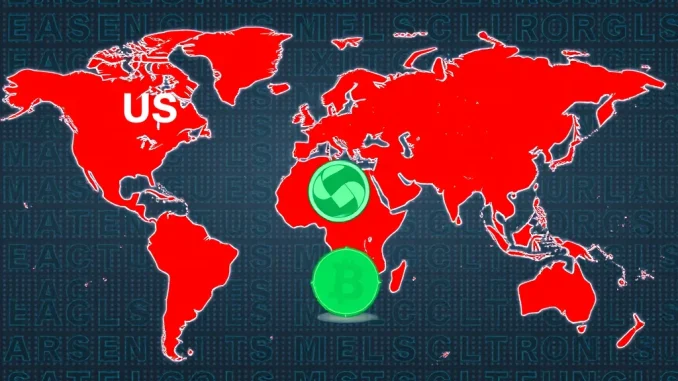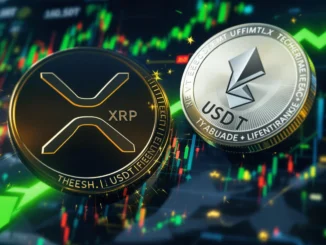
Hold onto your hats, crypto enthusiasts! The stablecoin giant, Tether, known for its flagship USDT, is making waves with a potentially seismic shift in its global strategy. Could we be witnessing a major market exit from the United States and European Union for USDT? Let’s dive into the latest developments and understand what this means for you and the future of stablecoins.
Tether’s Bold Stance on Regulation and Market Exit
Tether CEO Paolo Ardoino has dropped a bombshell, indicating that the company is bracing for a future where USDT might not operate within the regulatory landscapes of the U.S. and Europe. This isn’t just speculation; it’s a proactive stance as regulation in these regions tightens around stablecoins. Instead of bending USDT to fit the evolving U.S. stablecoin laws, Tether is exploring a more assertive path: launching a brand new, fully compliant stablecoin specifically designed for these markets.
Think of it like this:
- USDT’s Current Path: Continuing its focus on emerging markets where it has seen massive adoption and fewer regulatory hurdles.
- New Compliant Stablecoin: A fresh digital currency tailored to meet the stringent demands of U.S. and EU regulations.
This strategic bifurcation signals a significant shift in how Tether views global stablecoin operations. It’s not about abandoning key markets but rather adapting to the increasingly complex web of international financial rules.
Why Consider a Market Exit? Navigating the Regulatory Maze
The crypto world is no stranger to regulatory scrutiny, and stablecoins, due to their pegged value and potential systemic importance, are particularly in the spotlight. Several factors are likely driving Tether’s contemplation of a market exit for USDT in the US and EU:
- Evolving U.S. Stablecoin Laws: The regulatory framework in the U.S. is becoming more defined, potentially imposing stricter requirements on stablecoin issuers. Instead of retrofitting USDT, creating a new entity might offer more agility.
- EU’s MiCA Regulations: The EU’s Markets in Crypto-Assets (MiCA) framework is another significant piece of legislation. Recent EU rules have already prompted Binance to delist USDT in Europe, highlighting the immediate impact of these regulations.
- Focus on Emerging Markets: USDT has found a strong foothold in emerging economies. Concentrating efforts in these regions, where adoption is booming and regulatory landscapes might be more favorable, could be a strategic advantage.
- Proactive Compliance: By launching a separate, compliant stablecoin for the U.S. and EU, Tether demonstrates a commitment to regulatory adherence without disrupting USDT’s existing ecosystem.
It’s a complex chessboard, and Tether is making strategic moves to ensure its long-term viability and market presence.
The Future of USDT: Emerging Markets and Secondary Markets
While considering a potential market exit from primary markets in the US and EU for USDT, Tether remains optimistic about USDT’s continued presence on secondary markets within these regions. What does this mean practically?
Imagine it this way:
| Market Type | USDT Status | Implications |
|---|---|---|
| Primary Markets (Direct Issuance/Redemption) | Potentially limited or exited in US/EU | Users might not be able to directly buy/redeem USDT from Tether in these regions. |
| Secondary Markets (Exchanges, DeFi Platforms) | Aiming for continued presence | USDT could still be traded and used on exchanges and DeFi platforms within the US/EU, even if direct Tether operations are restricted. |
This distinction is crucial. While direct interaction with Tether for USDT might become restricted, the existing ecosystem of exchanges and decentralized finance platforms could still support USDT trading and usage, depending on regulatory interpretations and enforcement.
New Compliant Stablecoins: A Two-Pronged Approach to Regulation
Tether isn’t just reacting to regulation; it’s proactively shaping its future by backing new regionally compliant stablecoins for both the U.S. and EU. This signals a sophisticated, two-pronged strategy:
- Maintain USDT’s Trajectory: Continue to nurture USDT’s growth in emerging markets and navigate secondary market presence in regulated regions.
- Embrace Compliance with New Stablecoins: Launch distinct stablecoins tailored to meet the specific regulatory demands of the U.S. and EU, ensuring access to these crucial markets in a compliant manner.
This dual approach allows Tether to cater to diverse market needs and regulatory environments simultaneously. It’s a move that could redefine Tether’s global footprint and potentially set a precedent for other stablecoin issuers navigating the complexities of international crypto regulation.
The Road Ahead: What Does This Mean for Crypto?
Tether’s potential strategic shift is a stark reminder of the evolving regulatory landscape in the cryptocurrency world. Here’s what you should consider:
- Increased Regulatory Scrutiny: Stablecoins are under intense regulatory focus globally. Expect more stringent rules and compliance requirements in the future.
- Market Fragmentation: We might see a divergence in stablecoin offerings, with regionally compliant options emerging alongside existing global stablecoins like USDT.
- Innovation in Compliance: Tether’s move could spur innovation in how stablecoin issuers approach regulatory compliance, potentially leading to more tailored and geographically specific stablecoin solutions.
- USDT’s Enduring Role: Despite potential market shifts, USDT’s established network effects and deep liquidity in emerging markets suggest it will remain a significant player in the crypto ecosystem.
The crypto world is anything but static. Tether’s strategic considerations are a testament to the dynamic interplay between innovation and regulation. As the story unfolds, one thing is clear: the future of stablecoins is being actively shaped, and the next chapter promises to be fascinating.
Conclusion: Navigating the New Stablecoin Era
Tether’s proactive approach to regulatory challenges, including the possibility of a market exit for USDT in the US and EU while simultaneously developing compliant alternatives, is a defining moment for the stablecoin sector. It highlights the critical need for adaptability and strategic foresight in the face of evolving global regulations. Whether you’re a seasoned crypto trader or just dipping your toes in, understanding these shifts is crucial. The stablecoin landscape is maturing, and Tether’s moves are a powerful signal of the changes underway. Stay informed, stay agile, and brace yourself for the next exciting phase of crypto evolution!



